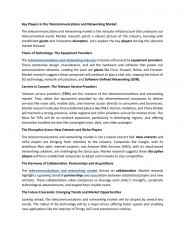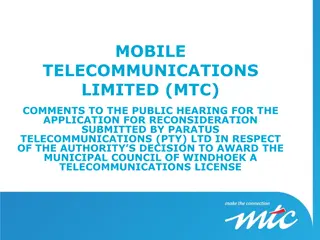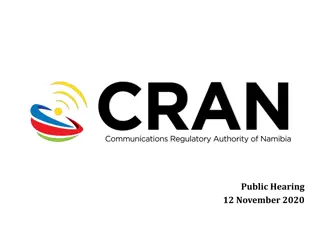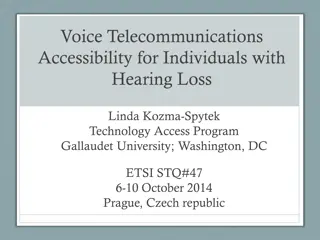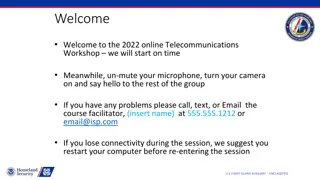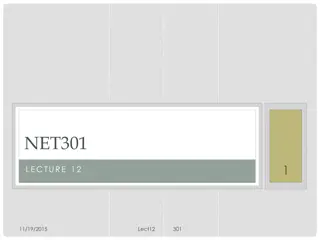Understanding Telecommunications Transmission Systems
Transmission systems in telecommunications provide circuits between network nodes using channels for bidirectional communication. Channels can range from simple audio circuits to complex satellite systems. Signals can be analog or digital, each with its unique characteristics. Bandwidth is crucial for analog signals, while digital signals offer advantages in noise immunity and signal regeneration. Both analog and digital signals can be transmitted over appropriate channels, showcasing the versatility of modern communication technology.
Download Presentation

Please find below an Image/Link to download the presentation.
The content on the website is provided AS IS for your information and personal use only. It may not be sold, licensed, or shared on other websites without obtaining consent from the author. Download presentation by click this link. If you encounter any issues during the download, it is possible that the publisher has removed the file from their server.
E N D
Presentation Transcript
Telecommunications Transmission
Introduction Transmission systems provide circuits between the nodes of a telecommunications network. If a circuit uses a separate transmission path for each direction, these are called Channels . In general , a complete channel passes through sending equipment at a terminal station, , transmission link which may contain repeaters at intermediate stations and receiving equipment at another terminal station. However present day transmission systems range in complexity from simple unamplified audio-frequency circuits to satellite communication systems.
Analog and digital Both channels and signals that they convey can be classified into two broad classes. Analog Digital Analog: Analog signal is a continuous function of time. At any instant it may have any value between limits set by the maximum power that can be transmitted. Eg: Speech signals. Analog signals are mentioned in terms of bandwidth
Contd Bandwidth is a range of frequencies that an analog signal uses to convey information since a single sinusoidal waveform cannot convey any information. To transmit an analog signal without distortion, a channel must be a linear system but for digital signal it need not be linear. Eg: Telegraph channel whose output signal is provided by the operation of a relay.
Contd Digital: Digital signal can have only discrete values. The most common digital signal is a binary signal having only two values (Eg: mark and space or 0 and 1 ) Eg: Telegraph signals and binary coded data from computer. Digital signals are mentioned in terms of Bauds . Bauds : The number of signal elements transmitted per second is called the signaling rate in bauds.
Contd It does not follow any rule that analog signals must be transmitted over analog channel and digital signals over digital channels. Eg: data communication and voice frequency telegraphy over telephone lines are the examples of digital signals sent over analog circuits. Similarly Analog signals may be sent over digital channels by using analog to digital conversion. Eg: Use of PCM(pulse code modulation) to transmit speech.
Advantages of digital over analog Its immunity towards noise and interference. Eg: Error free transmission of a binary signal requires detection of presence or absence of each pulse and this can be done in the presence of high level noise also. It is possible to use regeneration provided the received signal is not so corrupted that it is detected erroneously. The transmission performance of digital circuits can be almost independent of their length where as analog signal deteriorate progressively over a distance.
Multiplexing and Demultiplexing If a link has greater bandwidth than the signals to be transmitted, the different channels can be combined to fill the bandwidth. At a sending terminals, the signals of different channels are combined to form a composite signal of wider bandwidth. This process is known as multiplexing At the receiving terminal, the signals are separated and retransmitted over different channels. This process is known as demultiplexing .
Baseband channel and Broadband channel (bearer channel) Baseband channel: The separate channels which enter and leave the terminal station are called baseband channels . Broadband or bearer channel: The transmission link which carries the multiplex signal is called broadband or bearer channel . Muldex or mux: The combination of multiplexer and demultiplexer at a terminal station are called as muldex or mux
Methods of multiplexing It is broadly classified into 2 types Frequency division multiplexing(FDM) Time division multiplexing(TDM) FDM: In FDM transmission, each base band channel uses the bearer channel for all the time but it is allotted with only a fraction of bandwidth. TDM: In TDM transmission, each baseband channel uses the entire bandwidth of the bearer channel but only for a fraction of the time.
Frequency Division Multiplexing (a) The original bandwidths. (b) The bandwidths raised in frequency. (b) The multiplexed channel.
Wavelength Division Multiplexing Wavelength division multiplexing.
Time Division Multiplexing (3) Multiplexing T1 streams into higher carriers.
Power levels A wide range of power levels are encountered in telecom transmission systems. It is therefore convenient to use a logarithmic unit of power and it is in decibels . Decibel(dB): It is defined as If the output power P2 is greater than the input power P1 , then the gain G in db is G=10 log10 p2 dB p1
Contd However if P2<P1 then the loss or attenuation in dB is L =10 log10 p1 dB p2 In some countries,the unit employed is Neper(N) Gain in neper = 10 loge p1 N p2 The gain of 1 Neper corresponds to 8.69 dB.
Contd The logarithmic unit of power is convenient when a number of circuits having gain or loss are connected in Tandem . The overall loss or gain of a number of circuits in tandem is simply the algebraic sum of their individual gain or losses measured in dB or Neper . Since a transmission system contains gains and losses, a signal will have different levels at different points in the system. Therefore it is convenient to express, levels at different points in the system in relation to chosen point called the zero reference point. The relative level of a signal at any other point in the system with respect to its level at the reference point is denoted by dBr.
Four wire circuits Principle of operation: It is necessary to use amplifiers to compensate for the attenuation or loss of a transmission path. Since most of the amplifiers are unidirectional, it is usually necessary to provide separate go and return direction of transmission. The term four wire circuit is been used, although the go and return paths may be provided by channels in a multiplex transmission system.
Contd At each end, the four-wire circuit must be connected to a two-wire line leading to a telephone. If both paths of the four-wire circuit were connected directly to the two-wire circuit at each end, a signal could circulate round the complete loop thus created. This would result in continuous oscillation, known as singing. Toavoidthis, the wire line at each end is connected to the four wire circuit by a four wire/two wire terminating set. This contains a Hybrid transformer (two cross connected transformers) and a line balance network whose impedance is similar to that of the two wire circuit over the required frequency band.
Contd The output signal from the receive amplifier causes equal voltages to be induced in the secondary windings of transformer T1. If the impedance of the two-wire line and the line balance are equal, then equal current flow in the primary windings of transformer T2. These windings are connected in antiphase, thus no EMF is induced in the secondary winding of T2 and no signal is applied to the input of the send amplifier. It should be noted that the output power from the receive amplifier divides equally between the two-wire line and the line balance. When a signal is applied from the two wire line, the cross connection between the transformer windings results in zero current in the line balance impedance. The power thus divides equally between the input of the send amplifier and the output of the receive amplifier, where it has no effect.
Echoes In a four wire circuit an imperfect line balance causes part of the signal energy transmitted in one direction to return in the other. The signal reflected to the speaker s end of the circuit is called talker echo and that at the listener s end is called Listener echo . The paths traversed by these echoes are as shown in the fig..
contd The effect of an echo is different for the speaker and the listener. For the speaker it interrupts his or her conversation and for the listener it reduces the intelligibility of the received speech. The talker echo is more troublesome it is louder. The annoying effect of echo increases with its magnitude and delay. This delay is exceeded on very long transcontinental and intercontinental circuits, so it is impossible to obtain both an adequately low transmission loss and an adequately high echo attenuation. In such circuits,it is necessary to control echo by fitting devices called echo suppressors or echo cancellers .
Echo suppressors and echo cancellers Echo suppressors consists of a voice-operated attenuator, which is fitted on one path of the four-wire circuit operated by speech signals on the other path. Whenever speech is being transmitted in one direction, transmission in the other direction is attenuated, thus interrupting the echo path. There is one such suppressor known as half echo suppressor at each end of the circuit. Echo cancellers are now also used. The echo is cancelled by subtracting a replica of it. This replica is synchronised by means of a filter, controlled by a feedback loop, which adopts to the transmission characteristic of the echo path and tracks any variation in it that may occur during a conversation.
Digital transmission Noise and Jitter: The principle advantage of PCM and other forms of digital transmission is that it is possible to obtain satisfactory transmission in the presence of cross talk & noise. It is a binary transmission, so it is necessary to detect only presence or absence of each pulse
contd Eg: consider an idealized train of unipolar pulses as shown in fig: The receiver compares the signal voltage Vs with a threshold voltage of V. When the noise voltage Vn is added, an error occurs if Vn > V In a bipolar signal, an error occurs if Vn > V. In digital transmission it is possible to use regenerative repeaters instead of analog amplifiers. A regenerative repeater samples the received waveform at intervals corresponding to the digit rate. If the received voltage at the sampling instant exceeds a threshold voltage, it triggers a pulse generator which sends a pulse to the next section of line.
Contd.. If the bipolar pulses are used, the received voltage is compared against both the positive and negative threshold in order to send output pulses of either polarity. The instants at which the pulses are retransmitted by a regenerative repeater are determined by local oscillator synchronized to the digital rate, which must be extracted from the received waveform. Variations in the extracted frequency can cause a periodic variation of the times of generated pulses which is known as Jitter .
Coders and decoders In PCM,each analog sample is applied to an analog-to-digital(A/D) converter, which produces a group of pulses that represents its voltage in a binary code. Coders are used for A/D conversions. At the receiving end, a Digital to Analog(D/A) converter performs the inverse process. Decoders are used for D/A conversion. They need to perform their operations with in the duration of the timeslot of one channel. In PCM, each speech sample is coded independently.
Transmission performance in telephony In a telephone connection the complete path includes The air path from the talkers mouth to a telephone transmitter From a telephone receiver to the listeners ears In addition to the telephones and the switched connection between them. Overall attenuation of such a path is thus expressed in terms of overall loudness rating (OLR) in decibels.
OLR(overall loudness rating) The OLR is measured by comparing the perceived loudness of the received sound, with that from a standard speech path called as the Intermediate Reference System which is defined by the CCITT. In IDN(Integrated Digital Network) all the inter exchange links have zero attenuation with 0 tolerance. The variation is due to only customer lines, telephones and A/D conversion in local exchanges.
Transmission systems The circuit comprising of National Telecom Network fall into Customers lines Junction circuits Trunk circuits Customers lines are huge in number and therefore need to be provided as economical as possible. Traditionally local network have consisted of balanced pair of audio cables, using the smallest wire guage.
Contd Junction Networks have also used audio cables. Since the number of circuits are less compare to customer access networks, it is economic for these cables to have larger conductors in order to reduce attenuation. Loading coils have also been used to reduce attenuation. trunk networks: Earlier 4-channel,12-channel & 24- channel systems were used on open wire line and balanced pair cables. But later high capacity FDM systems operating over coaxial cables and microwave radio links have been employed, apart from satellite communication systems


